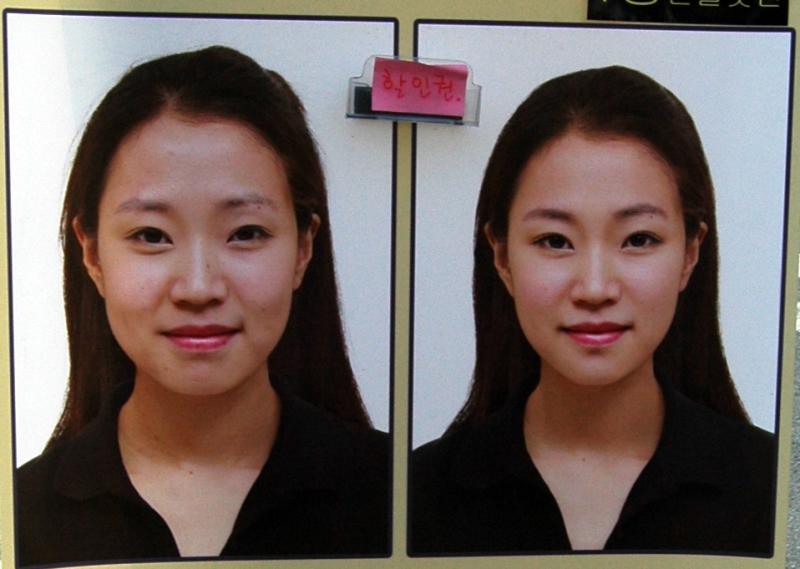M.C.,I've been researching and preparing to expatriate to Korea to teach english and have some questions about physical appearance. I've read that physical appearance is important and that job applications are usually accompanied by a photo.I have a shaved head, as well as a beard. How do Korean employers feel about short hair and facial hair?Also, most days, I wear a pair of khakis and a casual collared shirt (the sort of shirts sold at the Gap). Would this be acceptable attire for a typical day in the classroom? I would prefer to leave my daily shirt and tie routine behind with the cubicle job I'm escaping.
[M.C]
Exhibit A comes from a large banner promising a 10-minute Photoshop job on your job application photos:

Note the size of the face; the other changes are a bit hard to see in this cropped photo-of-a-photo. Small faces for women are apparently more attractive. The Joongang Daily recently published a survey of how important physical appearance is in Korea.
Physical appearance is DEFINITELY important in Korea. Sending a photo with your resume / CV is essentially a requirement, and it's not uncommon for Koreans to Photoshop that passport-like professional photo to perfection (see above). While walking around some areas of Seoul, you'll be hard-pressed to find some women without makeup.
With that said, you'll generally see men with short hair, very short hair, or no hair - short hair is more business-like or professional. Women tend to find more traditional styles go over better with students - and the bosses. The key is not 'correct hair length' but neatness. Looking neat, healthy, and wearing reasonably stylish clothes that fit well will take you farther in Korea than the same would in the Western world. Westerners often try to overlook someone who forgets to shave or brush their teeth - they had to drive their kid to school, or they were running late - but excuses like that don't fly very far here.
Regarding facial hair: neatness again is the key. If it's a well-kept beard, goatee, or mustache, it's likely to be accepted as your personal 'thing'. Not shaving for a couple days just looks like you're not trying, and would not be kosher. A current co-worker of mine maintains a shaved head with no complaints from the powers-that-be (to my knowledge).
As far as dress codes go, it's a rare school that will require suits and ties. This blog poll from last year indicates formal wear (e.g. slacks and dress shirts) is common, jeans and t-shirts are fine, while suits and ties are still rare. Working with kids means a more casual dress code (or an undefined one). While working with adults, I've worn slacks and ties - but then again, my adult students were professionals and came in for class wearing suits and ties. With adults at another school, khakis and polo shirts were fine as it was a more casual environment. I jokingly told some of my adult students that we were done with work, and we could loosen our ties and breathe a little easier. With children, jeans and t-shirts has generally been fine; if parents are coming in or there's a special event, you'll notice the Korean teachers dressing to impress. Follow their lead, especially if someone explicitly states what's coming up.
This does create sort of a problem: how do you pack for a job with an uncertain dress code? The simple answer is to try and learn what it is before you arrive. After an offer has been made and accepted, it's a good question to ask if it's not addressed in the contract or your previous conversations. Err on the side of conservative or formal dress to start. You'll also find clothes to be relatively easy to find - there are 50,000,000 people wearing clothes in Korea, after all - but larger or abnormal sizes can be more difficult to find.
Women, if your sizes involve anything larger than a B-cup or if you have hips, it'll be a bit harder to find things that fit. Non-anorexic women are having an easier time of it (anecdotally speaking) than in the past. Men, pants past a 36 inch waist require a bit more effort, while shirts get to XL before needing to find a 'big man' store. For either gender, shoes can be a bit more difficult if your feet happen to be larger - or wider - than average.
If you're looking for an interview, the rule of dress to impress comes to mind. It sounds a little silly to wear a suit and tie to an elementary school, but dress to impress anyway. Again, neatness, not just any old suit and tie. If you wouldn't want to be seen dead in it, you probably wouldn't want to be seen at an interview in it either.
From a long-term perspective, you're better off bringing along clothes that fit you well, that look spiffy on you, etc. In other words, leave the mustard yellow dress shirt behind, but pack your collection of band / retro t-shirts for those Saturday nights out on the town.
Readers, any tips on finding out the dress code ahead of time? Any thoughts on packing for the trip and lifestyle?
Do you have a question about Korea? I'm happy to answer, but do me a favor and search the blog archives first - there's a good chance your question has already been answered here. If it hasn't, e-mail me your specific question at chrisinsouthkorea AT gmail DOT com.
This post was originally published on my blog,Chris in South Korea. If you are reading this on another website and there is no linkback or credit given, you are reading an UNAUTHORIZED FEED.




 RSS Feed
RSS Feed
Recent comments